War: What is it good for?
Although the question has been tossed around for eons, there is no cookie-cutter answer. Certainties are thrown out the window. There is guarantee of surviving the next battle, of seeing a white flag wave, or of drinking from the victor’s cup; cold hard truths such as these have stirred the minds of battle-hardened soldiers for generations.
Among the chaos and cruelty, however, arose a reverence for the lion-hearted war gods and goddesses who played their cards on the battlefield. For they — and they alone — could possibly carry one to victory.
For hundreds of millennia, war gods have been worshiped by civilians and warriors alike; by kings far and wide. Giant temples constructed out of fear and veneration for these all-mighty deities. Those seeking protection, victory, heroic glory, and a hero’s death prayed in both times of trials and times of peace.
These infamous gods and goddesses had their altars built by the blood and brimstone of warfare.
Below we’ll review 8 of the ancient world’s most notorious war gods .
The 8 Most Revered War Gods of the Ancient World
Table of Contents
Apedemak — Ancient Nubian God of War
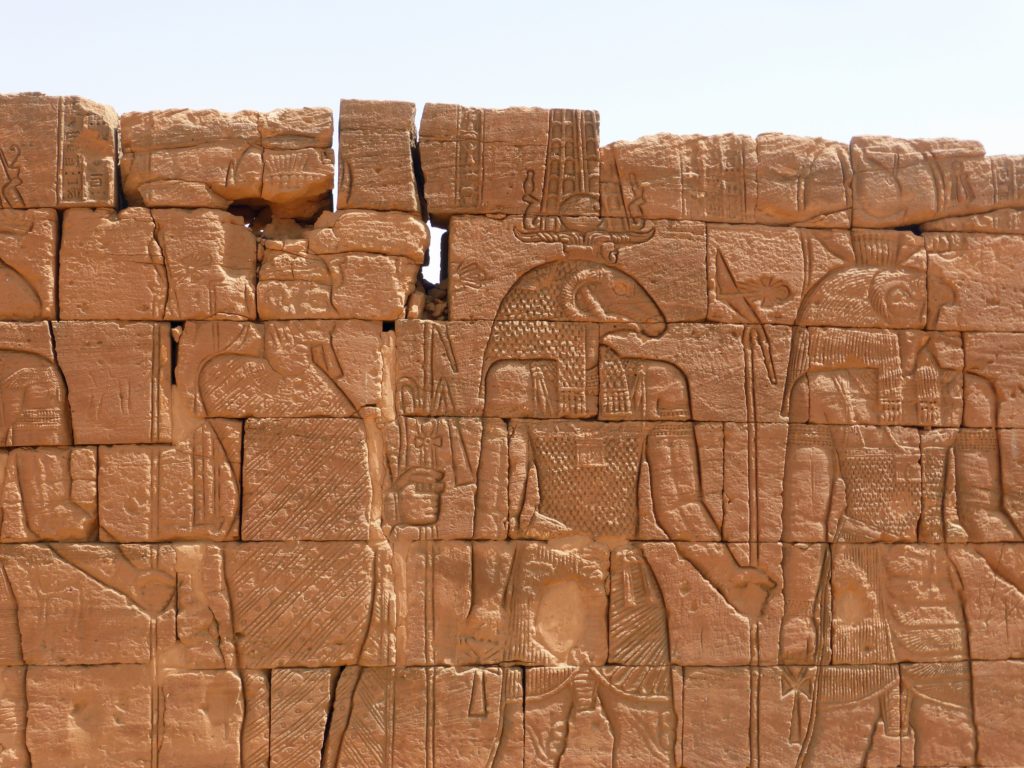
- Realm(s): War, Creation, Victory
- Weapon of Choice: Bow & Arrows
This war god was a favorite amongst the king of ancient Kush, Egypt’s southern neighbor.. Depicted most frequently as a man with the head of a lion — or as in the case at a temple in Naqa, three lion heads — Apedemak represented the unwavering authority of the ruling class in Kush.
The Kingdom of Kush was an absolute monarchy that was established in 1070 BC. It lay within the fertile land of the Nile Valley and was a hub for ironworking. Due to its close proximity to Egypt, there was a degree of cultural overlap: Records indicate that Egyptian gods were worshiped in some cities, that the people of Kush also mummified their dead, and that they also built burial pyramids. The kingdom was dissolved in 350 AD.
Securing Victory and Justice
Many of those kings that paid their respects to this war deity claimed his favor, swearing that he would lead them to victory against their adversaries. There are countless images of Apedemak in a complete leonine form on the walls of temples that show him devouring enemies and granting aid to kings in the midst of war.
Many would go on to speculate that this war god also embodies military justice: Depictions of him holding the shackles of prisoners of war as well as eating captives suggests grave outcomes for anyone opposing the rule of the sitting king. Such a cruel death was to be expected as punishment for such a daring crime, with multiple accounts confirming the feeding of captives to lions in Egypt, as well as in Kush during this time.
Whether or not this was practiced as an appeasement of Apedemak, or a display of his power, is unknown. Similar events may have occurred in Rome, as well, though most frequently during the many bloodsports that took place in the Colosseum.
The most notorious ruler in Kush to have done this is the tactical, one-eyed Kandake Amanirenas. She just so happened to have owned the lion as a pet in this case, and she made it a habit to piss off Augustus Caesar, the ruler of Rome.
The Many Shrines to Apedemak
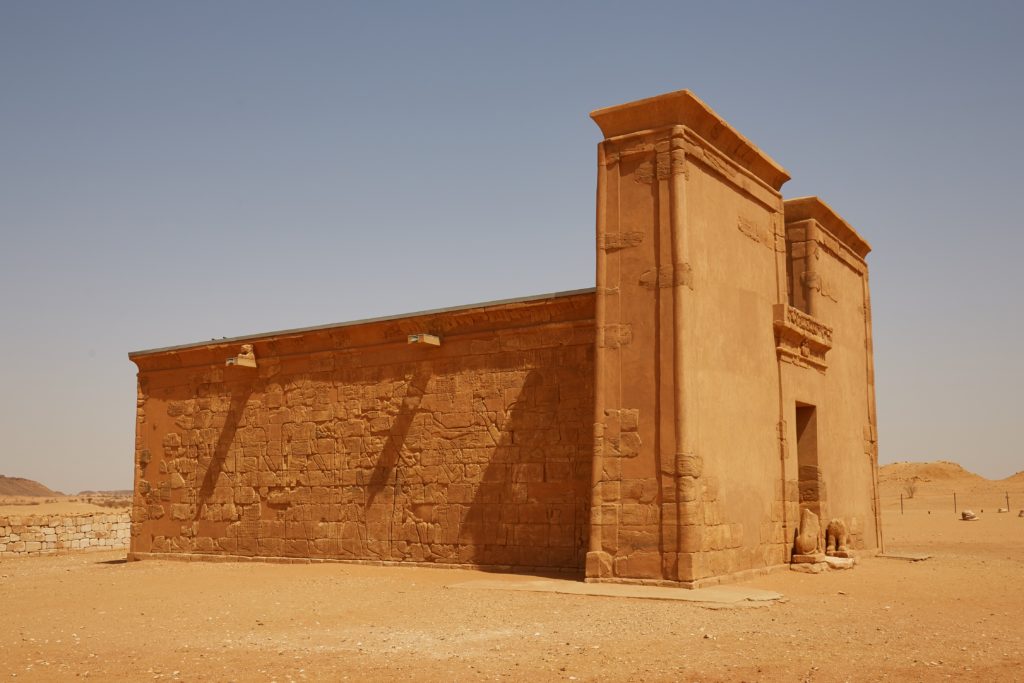
There is a temple dedicated to the lion-headed god Apedemak in Musawwarat es-Sufra: A massive Meroitic complex that dates back to the 3rd century BC. This complex is located in modern Western Bhutan in Sudan. It’s believed the majority of Musawwarat es-Sufra was constructed during the centralization of power in Meroe as the capital of the Kingdom of Kush.
More specifically, the location dedicated to Apedemak is referred to as The Lion Temple, with the construction beginning during the rule of King Arnekhamani. Text on the walls on Apedemak’s temple in Musawwarat es-Sufra refer to him as the “God at the head of Nubia,” thus emphasizing his importance in the region.
His role in the region is especially highlighted in his temple at Naqa which lays to the west of the temple of Amun, one of the primordial gods in all of Egyptian mythology. There, Apedemak is shown beside Amun and Horus, and is represented by a snake with the head of a lion on the outer temple edges.
In fact, Apedemak’s weapon, the bow, reflected his significance: Nubia – the region where Kush was located – was known as “Ta-Seti” by their Northern neighbors in Egypt, which translates to “Land of Bows”.
The Morrígan — Irish Goddess of War
- Religion/Culture: Ireland
- Realm(s): War, Fate, Death, Prophecies, Fertility
- Weapon of Choice: Spear
Now, this Irish war goddess may be making you see double. Or triple. Okay, honestly, sometimes you may not even really see her.
Often said to be a harbinger of death in the shape of a crow or a raven on the battlefield, The Morrígan has enough differing accounts throughout the ages to suggest that she was really three goddesses. Worshiped separately as Nemain, Badb, and Macha, these three war deities became known as the Morrígan: Powerful, unwavering warrior goddesses that could change the tides of a war.
Whenever they felt like it, the trio would also participate in the fighting themselves. The Morrígan would fight for the side they wanted to win; or, for the side destined to win. So frequently did Badb appear as a crow during combat that she became known as Badb Catha (“battle crow”).
Soldiers in the field would see a crow fly overhead and be impassioned to fight harder for whatever cause drove them. On another hand, the sight of the black bird would provoke others to lay down their arms in defeat.
Badb: Warrior Goddess of Dreams
Some interpretations of Badb relate her to the modern banshee, whose inhuman scream would foretell a death of an individual or a beloved family member. The ominous wail of the banshee would be akin to the prophesizing visions of Badb.
She would appear in the dreams of soldiers that were destined to die in the coming battle, washing their bloodied armor in a hag-like form. Badb shares a husband with her Morrígan sister, Nemain. The husband, known as Neit, is another Irish war god aided in the long battle against the Fomorians: Destructive, chaotic giants hostile to Ireland’s earliest civilizations that came from under the earth.
Nemain: The Crazy One?
Comparatively, the sister Nemain embodied the frenzied havoc of war. Called “battle fury,” during war she would purposefully cause confusion and panic on the field. Seeing formerly allied bands of warriors turn on one another is a favorite of hers. She enjoyed the ensuing chaos on the battlefield, oftentimes triggered by her piercing war cry.
Macha: The Raven
Then, in comes Macha. Also known as “the raven,” this Irish warrior goddess is most closely associated with Ireland itself, and especially its sovereignty. Macha was also viewed by many to be a fertility goddess. Not only was she a notable force to be reckoned with on the battlefield, having slaughtered thousands of men, but she became well known for her associations with feminine power and more specifically motherhood.
Regardless of just who makes up the fearless Morrígan, she is described as being a member of the Tuath Dé — a supernatural race in Irish mythology that usually resided in a land called The Otherworld (according to legends, The Otherworld was beneath bodies of water such as a lake or a sea). They were immensely talented individuals, with unique supernatural abilities each that worshiped an Earth-mother goddess named Danu.
READ MORE: Celtic Gods and Goddesses
Maahes — Ancient Egyptian War God
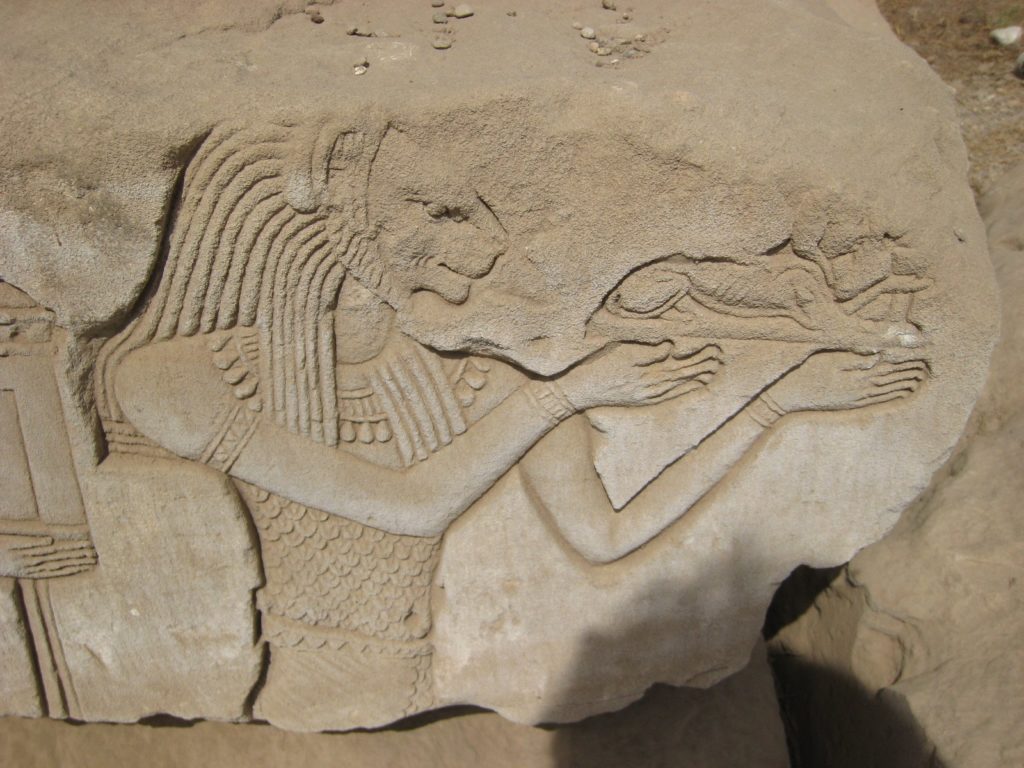
- Religion/Culture: Egypt
- Realm(s): War, Protection, Knives, Weather
- Weapon of Choice: Knife
Similar to other war gods, such as the Nubian god Apedemak, this Egyptian deity also happens to have the head of a lion and is known to meddle in wars and battles. His parentage is unknown and varied based whether you were in Upper or Lower Egypt. Some Egyptians believed Maahes is the son of either Ptah or Bastet, while others believe he was born to Sekhmet and Ra (in some variations, Sekhmet and Ptah).
The fathers of Maahes varied depending on whoever was determined to be the chief god of the time. However, there is no absolute evidence to completely lend fact to one side or another. If one was to take physical looks and divine role into account, then there is some confidence in saying his most likely mother was Sekhmet:
He is similar to Sekhmet in appearance and practice, being leonine war deities and all that.
Like mother, like son one could argue…
But! In case the lines were not blurred enough, there are so many similarities between this war god and the god of aromatherapy, Nefertum (another son of either feline goddesses), that scholars have speculated that Maahes may be an aspect of him. Also, although he is descended from great Egyptian cat gods , many speculate this great war god may not be Egyptian. In fact, many suggest he was adapted from Apedemak of Kush.
He is known to help Ra, one of the Egyptian sun gods, in his nightly fight against Apep, the god of chaos, to uphold the divine order. The fighting would occur after Apep, seeing Ra ferrying the sun through the Underworld, launched an attack.
Furthermore, Maahes is believed to safeguard the pharaohs of Egypt. More generally, he was tasked with maintaining Ma’at (balance), and punishing those who violated it, outside of being a war god.
READ MORE: Egyptian Gods and Goddesses
Guan Gong — Ancient Chinese War God
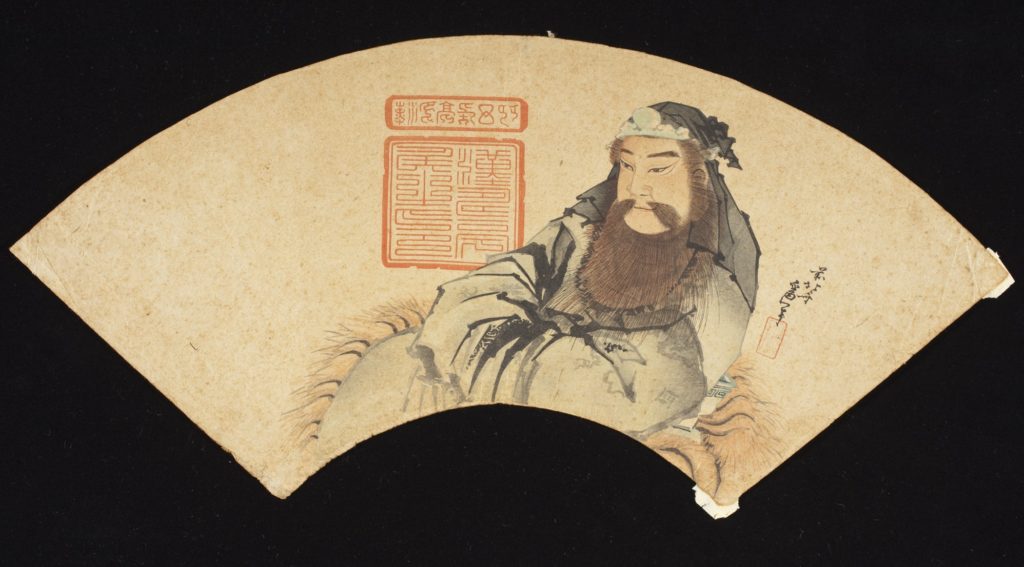
- Religion/Culture: China / Taoism / Chinese Buddhism / Confucianism
- Realm(s): War, Loyalty, Wealth
- Weapon of Choice: Guandao (Green Dragon Crescent Blade)
Next up is none other than Guan Gong. Once upon a time, this god was a mere man: a general during the Three Kingdoms period known as Guan Yu who served loyally under the warlord Liu Bei (the founder of the kingdom of Shu Han). He became an official Chinese god (of war) in 1594 when he was canonized by an emperor of the Ming Dynasty (1368-1644 AD).
However, his veneration amongst Chinese soldiers, civilians, and kings had been steadfast since his initial death and execution in 219 AD. Grand titles were granted to him posthumously over centuries. Tales of his exploits circulated throughout the country for generations, and the stories of his life and other characters during the Three Kingdoms period became the flesh of Luo Guanzhong’s novel Romance of the Three Kingdoms (1522).
People en masse were invested; they were mystified; they were awe-struck. To all who read Romance of the Three Kingdoms, the qualities Guan Yu had were to be more than just admired: These were qualities to exalt. Thus began Guan Yu’s ascension to becoming the Chinese god, Guan Gong.
Who Was Guang Gong?
A multitude of depictions of Guan Gong reveal further insights into his character and what he embodies. In art he is oftentimes shown with a striking beard (one described as “peerless” by Luo Guanzhong), donning green robes, and with a very red face.
As with all other war gods , there is a deeper purpose behind how he is represented: Scholars have reason to believe that the red of his face is derived from traditional Chinese opera costume, and that the red represents loyalty, courage, and bravery. Similar face paint is reflected in Peking Opera styles.
Even further so, although popular portrayals of this war god show him in green time and time again, it is not exactly known why this is. Some speculate that the color of his clothes reflect his pure intentions, show growth (economically, socially, and politically), or — if we base our observations on Peking Opera — then he is another heroic figure.
Guan Gong Across Cultures
As for his plentiful roles in more modern religious interpretations, he is viewed as a warrior sage in Confucianism, as Sangharama Bodhisattva in Chinese Buddhism, and as a deity in Taoism.
His most notable Warrior Temples include Guanlin Temple in Luoyang (his head’s final resting place), Guan Di Temple in Haizhou (the largest temple and built in his hometown), and the Zixiao Palace / Purple Cloud Temple in Hubei (a Taoist temple that claims to house the real Green Dragon Crescent Blade).
READ MORE: Chinese Gods and Goddessess
Ares — The Greek God of War
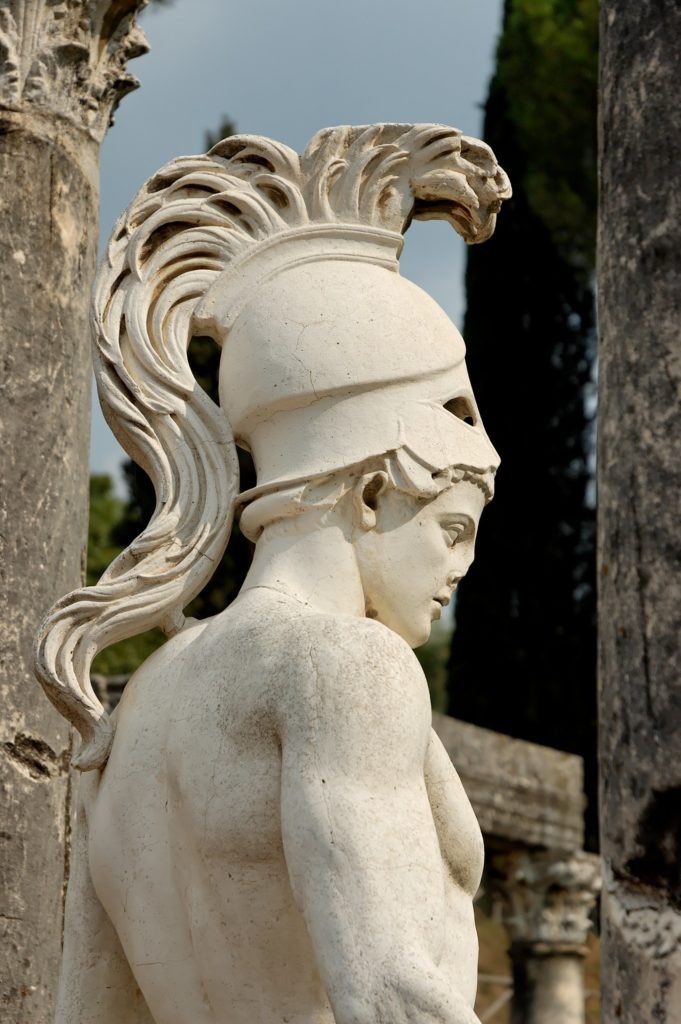
- Religion/Culture: Greece
- Realm(s): War
- Weapon of Choice: Spear & Aspis
Unlike most gods previously mentioned, Ares is not as popular among the common folk for his time. He was seen as one of the more destructive and moody Greek gods and goddesses (though he managed to woo the much sought-after goddess of love and beauty, Aphrodite).
In fact, it was his relationship with Aphrodite that ancient Greeks explored the thinly veiled connection between love, passion, and beauty and the ties these aspects have to warfare, fighting, and battlefield slaughter.
The unity between these two Greek gods is vague at best, though the Iliad by the beloved Greek poet Homer does show a consequential snowball effect of how the love can cause war; more specifically, when Paris takes Helen from Menelaos and causes the entirety of the Trojan War after selecting Aphrodite to be the most beautiful of the goddesses between Hera and Athena.
Of course there were other factors involved, including the goddess of discord causing the dispute in the first place, but I digress: more or less, for one of the greatest epics of the ancient world, we can thank Aphrodite for starting it and applaud Ares for, well, doing what he and his attendants do best in wa: total destruction.
Ares’ Powerful Children
Ares’ children with Aphrodite included twins Eros and Anteros, Harmonia, the twins Phobos and Deimos, Pothos, and Himeros.
While four of Ares’ sons help to make up the infamous Erotes (winged divines that accompany Aphrodite), his other sons, Phobos and Deimos often accompanied their father in battle.As the god of panic and fear, Phobos remained at his father’s side, being the personification of the emotional swell that is associated with combat.
Meanwhile, Deimos, a god of dread and terror, became the embodiment of the feelings soldiers felt prior to heading to the frontlines: His name alone was feared amongst soldiers throughout ancient Greece, since it is associated defeat and loss.
Another of Ares’ battle companions is his twin sister, Enyo — a warrior goddess in her own right. She was said to have driven Ares’ chariot into war, and had a fondness for battles that were particularly destructive; moreover, she was known to be quite the tactician, and enjoyed planning the siege of cities. Their sister, Eris, the goddess of strife and discordance, also found herself following wherever war tore through.
Although he touts an impressive entourage already, Ares’ long list of gods and goddesses at his disposal is not quite yet finished.
Divine beings such as Alala, the living war-cry, and her father, the demon personification of war, Polemos, are familiar with the ins-and-outs of warfare. There were also the Makhai, children of Eris and the spirits of battle and combat; likewise, the Androktasiai (more children of Eris), the personifications of manslaughter and a violent or cruel death during a battle, were also present during war.
Remember the Trojan War mentioned before? This collective of destructive, chaotic gods ran rampant through the streets of Troy after the city’s 10 year siege.
READ MORE: Greek Gods and Goddesses
Odin — Norse War God
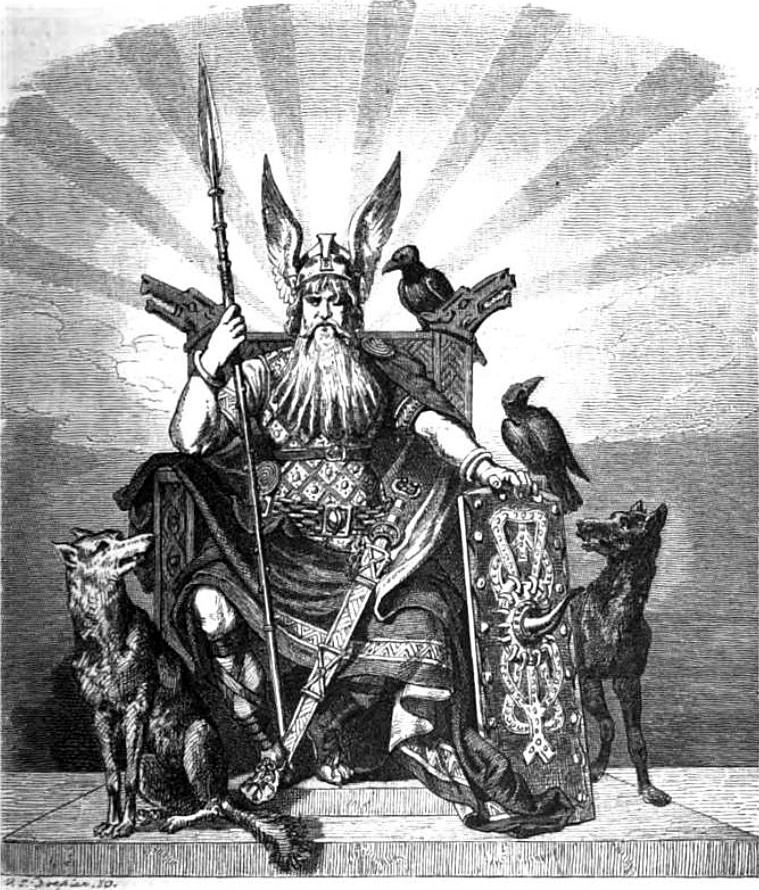
- Religion/Culture: Ancient Norse / Germanic
- Realm(s): War, Poetry, Magic, sometimes the god of Death
- Weapon of Choice: Spear
Being a father is hard enough — it’s hard to imagine being an “All-Father.” Still, Odin manages to somehow keep staving off the impending apocalypse of Ragnarok, home of the Norse gods and goddesses . This war god is the subject of many heroic tales and for a good reason: He helped create the world in the first place.
As the story goes, in the beginning there was only a void known as Ginnungagap: A whole vast nothingness. Two realms sprouted out from this void known as Niflheim, a land of ice which laid to the north of Ginnungagap, and Muspelheim, a land of lava that laid to the south.
It was in these extreme landscapes that the biggest players in Norse and Germanic mythos came to be made…
When the mix of atmosphere and aspects of Niflheim and Muspelheim occurred in the middle ground of Ginnungagap a jötunn named Ymir was brought into existence. Ymir’s sweat formed three more jötunn — from his armpits and his legs, respectively.
At some point, a cow named Audhumbla was also made in a similar fashion to Ymir and it was her responsibility to breastfeed the new jötunn. A little further on in time, Audhumbla licked a particularly salty ice block and helped the first of the gods appear: Buri.
Now, Buri went on to have a son named Borr, who went on to marry Bestla, and the couple had three sons: Vili, Ve, and Odin. It was these three brothers that killed Ymir and used his body to create the world as we know it (Midgard included).
In addition to all of this, the three brothers also created the first humans out of an ash and elm tree. They named them Ask and Embla; Odin was responsible for giving them initial life and spirit.
Considering all of this, it makes sense why Odin is depicted as an old, one-eyed man full of wisdom: He has literally been around since the beginning of time and had a hand in not only world building, but also in creating humankind.
Along with being viewed as a war god, Odin is also a patron of warriors. Brave soldiers faithful to this god believed they would be whisked away to glorious Valhalla after dying in battle to be looked after by him.
On the other hand, while Odin may maintain the halls of Valhalla and oversee its functions, it is the Valkyries that determine who is to live and who is to die in battle. Due to this, the sight of a Valkyrie can be interpreted as a divine protector or a herald of death. The role of the Valkyries is also to figure out which soldiers go to Valhalla and become einherjar, and which go to Freyja’s meadow-realm of Fólkvangr. Regardless of the decision, these female spirits that serve the All-Father are essential in the proper functioning of the Old Norse afterlife.
Hachiman — Japanese War God
- Religion/Culture: Shinto, Japanese Buddhism
- Realm(s): War, Protection, Archery, Agriculture
- Weapon of Choice: Bow & Arrows
Hachiman is frequently known to be a war god in Japan, with many across the realm believing him to be the deification of the 15th emperor, Ōjin, whose reign lasted from 270 to 310 AD.
At least, that is the common consensus. Born in 201 AD three years after his father’s death (this is interpreted to be more symbolic than literal), Ōjin did not become the emperor until 270 AD, at the age of 70, and he ruled for 40 years until he died at the age of 110. According to records, he had 28 children from a wife and ten concubines. His son — the legendary Saint Emperor Nintoku — is his successor.
While historians debate whether or not Ōjin was a real figure, his impact on the history of Japan is irrefutable. During his reign he was said to have led the charge on land reform, as well as encouraged cultural exchange with the mainland countries of China and Korea. The complete unification of imperial power, thus strengthening monarchical rule, is another event he was attributed with.
Fishermen and farmers of eld would pray to Hachiman (known then as Yahata) for a successful harvest, while those in the age of the samurai would look to him as a watchful deity of their personal clans. Warriors throughout time would look to Hachiman for guidance, while the Imperial House views him as their protector and guardian of the nation (a practice that began in the Nara Period of 710 to 792 AD).
During this time, the country’s capital was located within the city of Nara. The period was marked by the development of Buddhism throughout the region, leading to the construction of Buddhist temples throughout the realm in an effort to spiritually protect Japan. An oracle of the imperial court claimed that Hachiman promised the discovery of precious metals to cast a massive Buddha for the largest and most significant of these temples within Nara. Over time, Hachiman became referred to as Hachiman Diabosatsu and his identity as a guardian of temples leant to his wider role as guardian of the nation thereafter.
READ MORE: The History of Buddhism
However, it was during the tail end of the Hein Period (794-1185 AD) that this god of war flourished in popularity with the construction of numerous other Buddhist shrines. Over the course of his veneration, this god of war was often prayed to in accompany with Bishamon: The god of warriors and justice, and an aspect of Viśravaṇa.
READ MORE: The 19 Most Important Buddhist Gods
Being the guardian of the nation, it is only right that Hachiman is credited for the two divine winds that put an end to Kublai Khan’s aquatic invasion of Japan in 1274 AD. Subsequently, there is also a strong indication that Ōjin’s mother, Empress Jingū, was also known to be an avatar of Hachiman for her invasion of Korea sometime during her reign.
READ MORE: Japanese Gods and Goddesses
Mars — The Roman War God
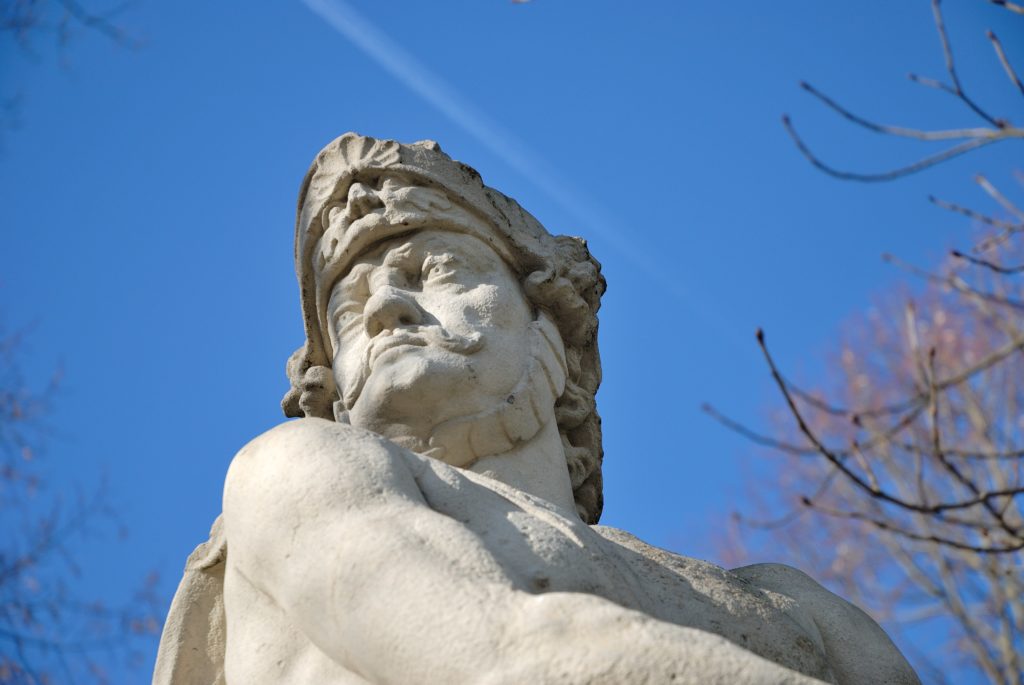
- Religion/Culture: Roman Empire
- Realm(s): War, Agriculture
- Weapon of Choice: Spear & Parma
Fair warning: Mars is very similar to the Greek god, Ares. Notwithstanding, despite this trend of coincidental similarities between Greek and Roman gods and goddesses, (something the Romans did to try and bring people into their empire) this Roman god is unique in his own way.
More than anything, this war god was the quintessential amalgamation of Roman ideals. His reverence of also being the god of agriculture symbolized the early years of the Republic, where the brunt of Roman soldiers were untrained farmers. Furthermore, he was believed to cleanse farmlands to ensure healthy crops. While he was not the only god known to toil in agriculture, he was respected enough to have sacrificial ceremonies performed in his honor. Comparatively, Ares does not have a dual realm, with his focus on war and war alone.
Yes, Mars was romantically connected to the Aphrodite-equivalent Venus, and yes he did have a twin sister that was a warrior goddess but in this case, her name is Bellona and not Enyo.
However, this is no copy-and-paste. No way!
Mars was a popular, powerful, and revered war god throughout the Roman world. Much of this has to do with his balanced traits; frankly, unlike Ares, Mars is almost likable. He is not impulsive, and instead thinks things through tactfully. Instead of being hot-headed, he is slow to anger. Likewise, he is regarded as being a martially virtuous god.
This Roman god was so liked by the public, he was considered only second to the primary god of the pantheon, Jupiter.
What is more is that Mars is also credited with being the father of the twins Romulus and Remus: the mythical founders of Rome.
As the story goes, a woman named Rhea Silvia was forced to become a Vestal Virgin by her uncle following the deposal of Silvia’s father, the king of Alba Longa. Since her uncle did not want any threat to his claim to the throne he saw this as the best route. Unfortunately for the new king, Rhea Silvia did become pregnant and, moreso, claimed the war god Mars as the father of her unborn children.
By this act, Mars is widely regarded as Rome’s divine protector, as well as a guardian to the Roman way of life. His presence was believed to have bolstered the army’s military strength while fighting.
It is no surprise that when considering that the month of March is named for him (Martius), most celebrations in his honor are held then. This would include everything from presenting military might to conducting rituals for Mars’ blessing before battle.